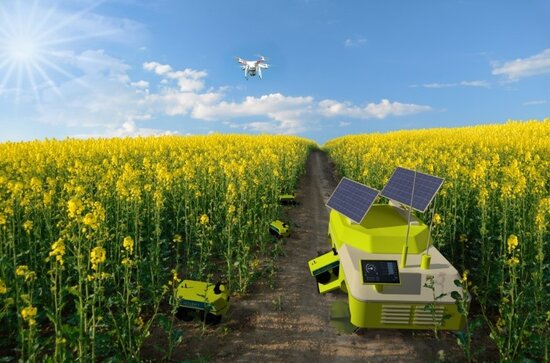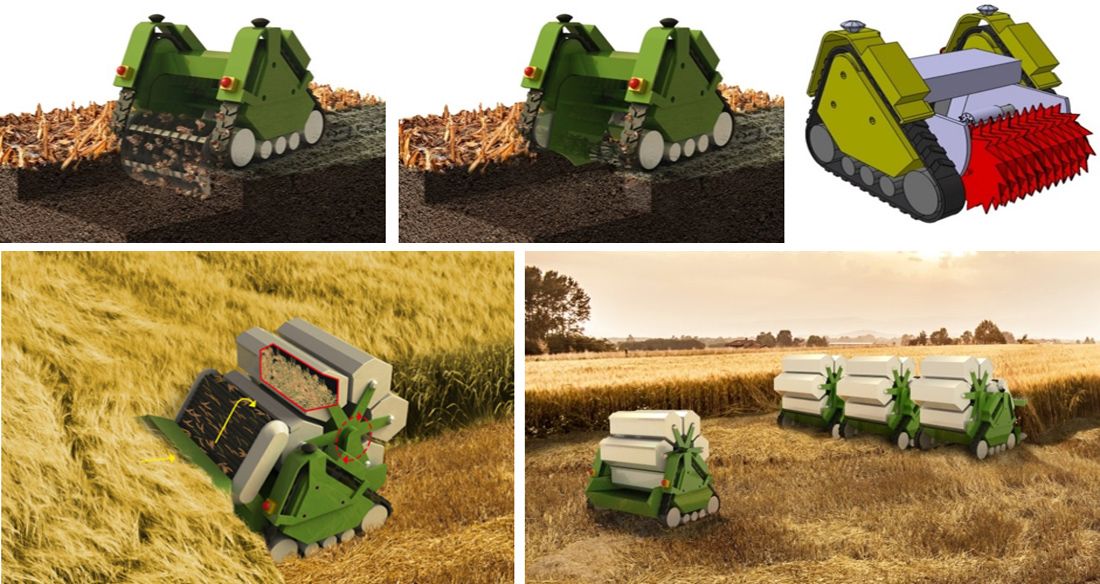Expertise
New crop production systems with autonomous agricultural machinery
Thomas de Witte | 02.05.2023
Current developments in the field of automation and digitalisation enable completely new possibilities to grow and harvest crops. What are possible future scenarios and which potentials do they offer? This has been investigated in a joint project with the participation of the Thünen Institute.
In recent decades, agricultural machinery became ever larger and more powerful in the arable production systems. The main driver of this development is the cost advantage that arises when larger machines are used, especially for labour costs. However, the trend towards ever larger machines also has negative side effects, such as increasing soil compaction and decreasing biodiversity.
At the same time, technical progress in the field of automation and digitalisation offers the possibility to develop completely different crop production systems based on small autonomous machines. This would allow to combine different plants on a small scale and to treat each plant according to its needs. In this way, the idea is to make much greater use of natural synergy effects between plants, to distribute resources more efficiently and to reduce negative environmental effects. However, it is not certain that autonomous small machines will be established in the process of automation in arable farming. Various development paths are conceivable, ranging from autonomous small machines to autonomous large machines or the combination of both.
Which development path will be taken is still open. For this reason, the Thünen Institute of Farm Economics, the Institute for Mobile Machinery and Commercial Vehicles of the Technical University Braunschweig and the Julius Kühn Institute for Application Techniques in Plant Protection conducted a joint project to develop scenarios of future crop production systems based on autonomous agricultural machinery. and evaluated their potential benefits.
In the scenario with autonomous large machines, only marginal improvements in economic and agronomic terms occurred compared to current production systems. A comparison of operating costs for grain harvesting and tillage with very large and small machines shows that in less capital-intensive operations as tillage and seeding small machines can become competitive, if labour costs can be left out. However, harvesting is not competitive with small machines in current machine concepts, even without labour costs. The calculations are published in the Journal of Cultivated Plants.
However, potential agronomic and economic advantages from a small-scale combination of different plants can only be realized if machines are available that allow separate treatments and harvests of the different crops which are combined in the same field. This will only be possible if almost all operations, especially harvesting, are carried out by small machines. For this reason, a scenario with autonomous small-scale machinery was designed for wheat production. With the aim of realizing cost reduction potentials, a modular robot concept was developed for the harvest and soil cultivation, which are very energy-intensive and thus require a high battery capacity. The crop care operations were implemented with a micro-robot concept. To be able to implement the harvest with small machines, the processes of "grain cutting and threshing", "straw separation", "straw chopping" and "straw distribution" were decoupled compared to today's combines. The small robots only cut the ear in the field, while special transport robots (right in the picture) transport the ears in transport boxes to the edge of the field and overload them into a trailer. Threshing takes place stationary on the farm.
Small machines have the potential to revolutionise crop production
Overall, the scenario analysis showed that small autonomous machines have the potential to completely change existing crop production systems. This offers in principle the opportunity to establish an arable farming system with less negative impact on the environment. The opportunities stem less from possible cost savings, but mainly from the possibility to vary plants on a small scale and to combine them with each other.
There are numerous references in the literature to the ecological benefits of higher biodiversity in the field. However, there are only a few studies that make concrete statements about agronomic advantages and yield effects based on field trials. In addition, the trials were usually carried out with more exotic crops and not with the main arable crops. There is a considerable need for research here if the outlined vision shall become reality.
In terms of economic viability, the highest hurdles are currently the costs for precise navigation (RTK licences, sensor) as well as for communication and battery technology. However, a large cost reduction potential can be expected here in the future.
Further results can be found in the project report and in the Journal of Cultivated Plants.










